This is our ultimate guide to bonsai trees. I remember the first time I saw a bonsai tree, my friends were playing Mario Kart and sharing popcorn in the other room, and I was transfixed by their dad’s collection of miniature trees. Ever since I’ve had an unparalleled love for bonsai trees.
When we say this is an ultimate guide to bonsai trees, we mean ultimate, with everything from bonsai history, the contemporary fashion for pruning, and our guide to growing bonsai trees in Australia, from a bonsai species guide to watering plans and step-by-step guides to repotting bonsais.
More...

Nathan from Aussie Green Thumb standing beside a stunning bonsai.
What is a Bonsai Tree?

When we compile plant overviews, we usually refer to Latin names and share the natural habits of plants, and how they grow in the wild, but bonsai trees are entirely unnatural, perfectly manicured miniature trees.
Bonsai trees are the ultimate test of a gardeners skill, in particular their ability to demonstrate a compassionate command of nature. After all, that is what gardening is; a way to manage and manicure our own small plot of earth to meet our own goals.
There are trees that are easier to grow into bonsai trees, but the art of growing bonsai (and it is an art) is about pruning, root trimming and mimicking nature to the best of our abilities.
Bonsai Tree History
Bonsai is a practice that is much older than its name. Bonsai translates from the Japanese ‘bon-sai’ as ‘planted in a container and was given its name by Zen Buddhists, who adopted the horticultural art form as a way to connect to nature and celebrate its beauty in small spaces limited by a lifestyle of austerity and grace.
The practice of bonsai can be traced back to the Chinese art of pun-tsai as early as 700AD at the height of the Chinese Empire, and while they held meditative properties for their growers, were grown as gifts and ornaments for wealthy collectors.
Interestingly, the adoption of Chinese pun-tsai into bonsai saw larger bonsai being grown - implied by the translations (pun = pan/tray ; bon = pot/container).
Over time, the more traditional pun-tsai pans were reintroduced into bonsai and the trees reduced further in size, testing the skills of bonsai growers in Japan.
It was relatively recently that bonsai became popular around the world, despite evidence of bonsai being grown on a piece of coral by explorers in the 1600s discovering and appreciating the practice.
Like many of our modern tastes for East Asian planting, they were properly introduced at the 1910 Japan-Britain Exhibition, where cherry trees, Acers and bonsai became infinitely desirable for their beauty and their vivid blossom and autumnal colour.
10 Bonsai Trees to Grow in Australia
Before we explore the ins and out of pruning, care and bonsai fashion, it’s important that we understand the range of trees that can be grown as bonsai.
There is no limit on what trees you can grow, but there are bonsai trees that grow well in Australia, and trees that work better as bonsai thanks to their smaller leaves.


Get Your Free Guide:
Master Growing Australian Natives eBook
A Must Have Complete Guide for Every Australian Garden
Get Your Free Guide:
Master Growing Australian Natives eBook
A Must Have Complete Guide for Every Australian Garden
Bonsai fruit trees are probably the most magical trees, and most engaging for new growers as they continue on their natural path to fruiting depending on age, rather than size, which goes against what we typically understand as gardeners.
The ability to grow a full-sized lemon on a bonsai tree is enthralling, but it can be just as wonderful to see a mighty oak twisted and curved into a fraction of its size.
1. Oak Bonsai Tree
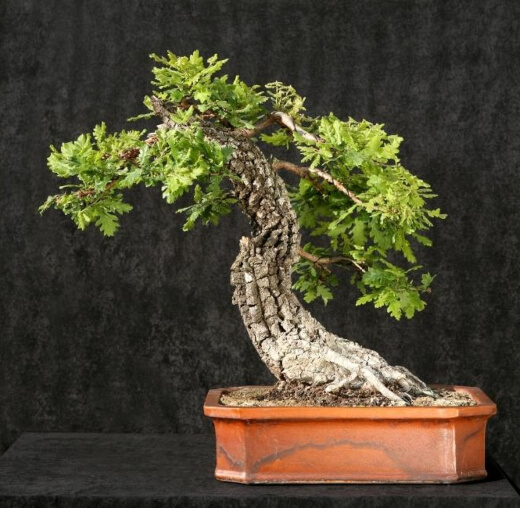
Oak trees make utterly beautiful bonsais. Their leaves are distinctive and grow smaller than their full-sized counterparts, but they develop acorns at the same rate if they are kept outdoors and pruned at the right time.
Oak tree bonsais can be grown from acorns if you have patience but they really come into their own after around 10-15 years of growth when they begin developing gnarled stems covered in tough bark.
Their young shoots are malleable enough to train with wire, and they are resilient to infection after pruning too.
2. Cherry Bonsai Tree
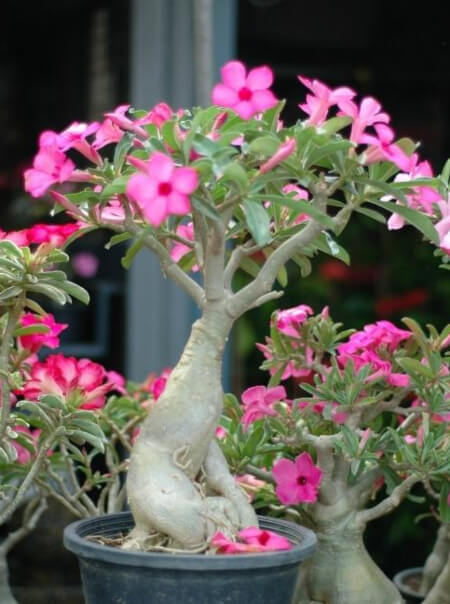
The sincerest form of beauty in the natural world is spring blossom. It conjures up mythical imagery and depending on the tree can fill spaces with intense fragrances.
Cherry tree blossoms have a wonderful smell, but it’s their unmistakably cloudy plumes of blossom that cover entire trees with whites, pinks and reds that is most inspiring.
They are also a wonderful nod to the traditions of Japanese Zen Buddhists whose reverence for trees as markers of the season has bled into Japanese and global culture more widely.
3. Crab Apple (Malus) Bonsai
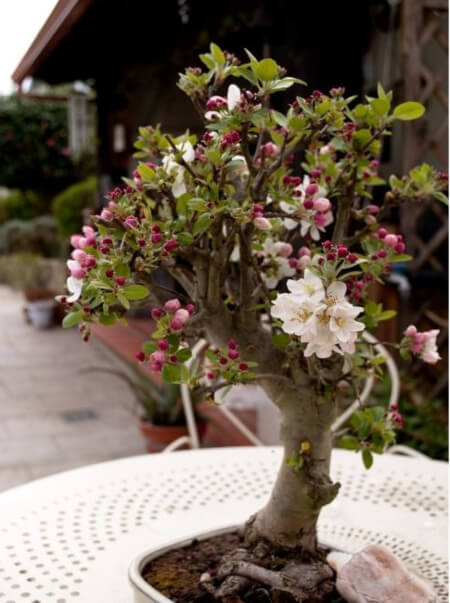
Bonsai Fruit Trees, or fruiting bonsai trees, are probably the most complicated bonsais to keep going. Trees that bear fruit are less likely to thrive in containers, as they have reproductive instincts to produce annual fruits and expand their gene pool.
Because of this instinct to fruit, bonsai fruit trees require slightly different conditions, and more regular fertilisation to support their flowers and fruits.
If you grow bonsai malus indoors you’ll need to pollinate the flowers with a paintbrush too, to ensure reliable fruiting, but the effort is well worth it for a miniaturised piece of nature.
4. Juniper Bonsai
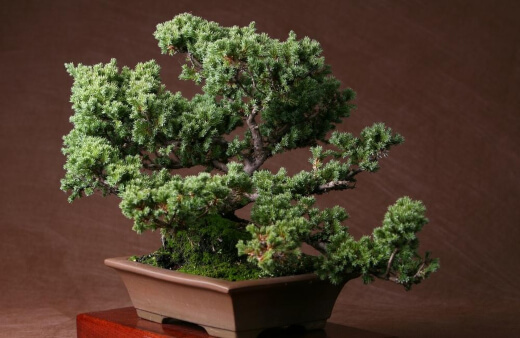
Juniper bonsai trees are mind-blowingly beautiful evergreen trees that are easy to shape and very forgiving for amateur bonsai keepers. Because of their tight foliage, they can be clipped quite lazily into a rough shape, with leaves that will cover their general shape, rather than focussing on formal or traditional bonsai structures.
While pruning into these traditional topiary shapes is an easy option, juniper has beautiful bark, so if you want more of a challenge, designing your bonsai into windswept forms, or arched trees that seem to counterweight their pots will give you a really traditional bonsai.
If you’re into gin, juniper berries are also a key ingredient in gin - so a miniature juniper tree on the patio is a great bonsai for making preserves and liqueurs.
5. Conifer Bonsai
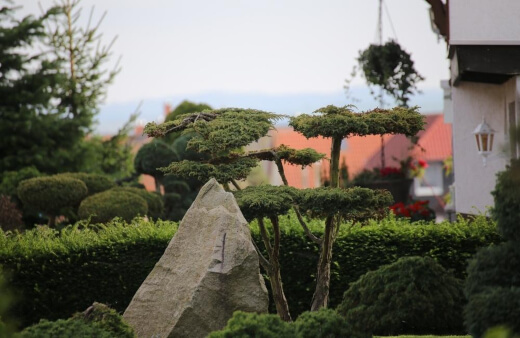
Conifers are fast growing so give great results from young plants really quickly. They do require more regular pruning and they are very thirsty plants (anyone who has conifers in their garden will know how quickly they drink up the water in the earth around them).
Another tip for confider bonsai is to research how to prune full-size conifers. Like pine trees they don’t like pruning, and will not grow from old wood, so need shaping in advance.
By pruning new shoots when you see them you can control the future growth, but cutting back any old growth will be permanent and it will not sprout again.
6. Portuguese Laurel Bonsai
Portuguese Laurel makes excellent contemporary bonsai trees. With their glossy leaves and smooth stems, they can be considered boring compared to other bonsai with gnarled stems, but that brings plenty of benefits too.
They are easy to shape and grow well from old growth so are really simple to keep alive for anyone worried that bonsai care is too complicated.
Portuguese Laurel Bonsai trees also flower, sometimes twice a year, with intriguing creamy flower spikes.
7. Bonsai Apple Tree
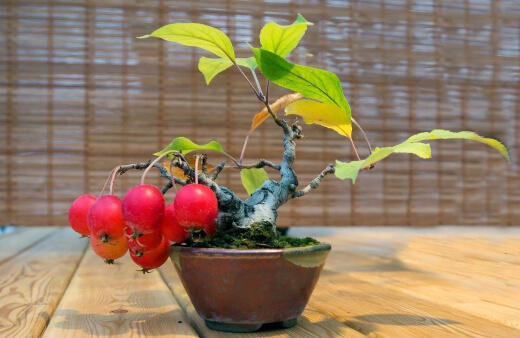
Bonsai Apple Trees will blow your mind if you find yourself doubting how well bonsai can fruit. Full-sized apples can grow happily on bonsai, but it’s to pinch out fruit so you have no more than one apple per foot of tree.
If your miniature tree is trying to develop too many fruits, they will all fail to ripen, so help the tree to focus its energy by punching out young fruits, and repot your bonsai into a new pot every few years with enriched soil to make sure it has enough nutrients to set fruit.
Like all bonsai fruit trees, bonsai apples should be grown outdoors.
8. Eucalyptus Bonsai
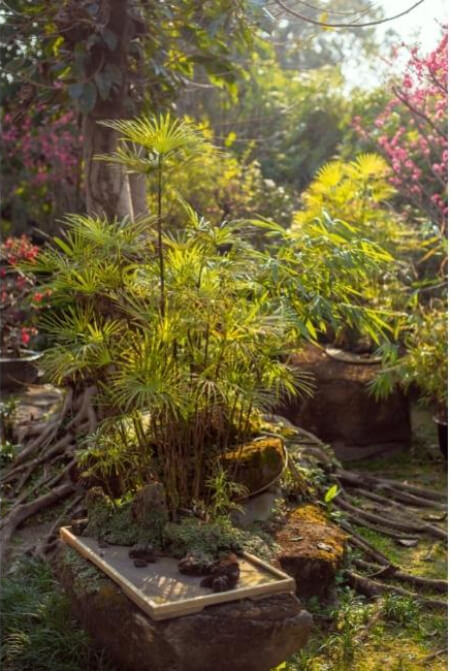
Eucalyptus are by no means a traditional bonsai, but they will grow happily indoors and outdoors, and cope with less regular watering than most bonsai trees.
Their foliage is shrunken slightly by the bonsai procure, but the same leaf form is recognisable and the essential oils that fill the leaves will fill patios with fragrance on warm days.
9. Pine Bonsai Trees

Pine trees have always been a staple part of oriental gardens. Their delicate needles are often pruned to perfection in the grand stroll gardens of Japan to highlight the shapes of the tree within the wider landscape.
Growing bonsai pine trees needs serious care and attention as, like conifers, they don’t grow from old wood. Pruning pine trees is all about pinching out young shoots to encourage slower growth.
When you pinch young shoots it slows the growth and can encourage side shoots. These side shoots can be pruned later in the year for the desired shape, but you’ll need to space in the longer term as 30-year-old bonsai pine trees tend to be around 3-4ft tall (which doesn’t sound that miniature, but mature full-size pine trees can be over 260ft in contrast)
10. Pomegranate Bonsai

Pomegranates are as magical in reality as they are in legend, with uniquely flavoured fruits that have long been a symbol of passion. Bonsai pomegranates are adorable miniatures, with fruits that stick to the scale of the tree, which can lead to a beautiful small tree covered in tiny crimson-orange fruits.
The tiny fruits are edible but are mostly for display as they don’t form the same seed capsules when grown in miniature.
In addition to the list above, China doll plant also works perfectly as a plant for bonsai so be sure to check out our comprehensive guide on how to grow China doll plant in Australia.
Best Containers for Bonsai Trees
As we discussed in the bonsai tree history section earlier, the name bonsai is taken from the Chinese pun-tsai, meaning ‘planted in a tray’. There has never been a bigger clue about how to plant something than this name.
Bonsai need planting in shallow, well-drained pots. So specialist pots are recommended, but you can be more creative with this if you like, with contemporary bonsai growers using everything from hollowed-out bricks to crushed drinks cans.
By planting bonsai trees in shallow containers it creates a microcosm with an independent ecosystem that the tree adapts to, so it produces short fibrous roots rather than long sturdy tap roots.
The top of the tree has the instincts to grow the same way, and develop leaves and bark just as a full-sized tree would, but the bonsai pot restricts its height by forcing the tree to mirror its diminutive roots.
Traditional bonsai pots will usually be glazed ceramics. The only prerequisite for bonsai pots is that they should be well-drained at their base, but limit transpiration from the sides of their pots.
Therefore terracotta trays, like the ones you would typically use for alpine plants, are not appropriate for bonsai because they allow too much water to escape from the sides.
How to Grow Bonsai Trees in Australia

You can’t go far wrong with any of the above varieties, but there are some simple rules to learn when you start growing bonsai, and a few basic principles of growing bonsai that will help you make decisions over their care for years to come.
Firstly, remember that bonsais are trees. Trees are happy through periods of drought, flooding and high winds. It’s what makes them such successful plants, and why they often live in nature for hundreds if not thousands of years.
You wouldn’t grow a tree indoors, and bonsais are the same. They much prefer to live outdoors, as the natural weather patterns, especially in colder climates, is perfect for them.
If you do decide to grow your bonsai indoors though, your most important job is taking on the role of mother nature. Essentially duplicating the weather outside, watering when it rains and ensuring your trees get as much natural light as possible.
It might all sound a bit obvious, but bonsais are mostly sold as houseplants in garden centres, but they always prefer to live outside in the garden, raised up on a table, or in a decorative but humble container.
Growing Bonsai Outdoors
Bonsai trees prefer to be grown outdoors and look brilliant on patios, or as a central feature on a garden table, but it’s important to give them proper drainage and position them correctly in the garden.
We’ll cover watering later but if you grow bonsais outdoors they should only need watering during drought periods as they will receive enough water to support their leaves from the rain.
Make sure you choose somewhere you can see your tree all the time too. It’s easy to make excuses and put off bonsai care, so making sure your trees are visible gives you the incentive to prune them, test their soil, and re-pot them whenever you see the signs.
While 99% of trees will be winter hardy in most of Australia, there are a few that need complete protection from frosts, like tropical flowering trees such as Plumeria or Mediterranean citruses which can be grown outdoors all year round in some parts of Australia but need bringing indoors if there is a risk of temperatures below 5°C.
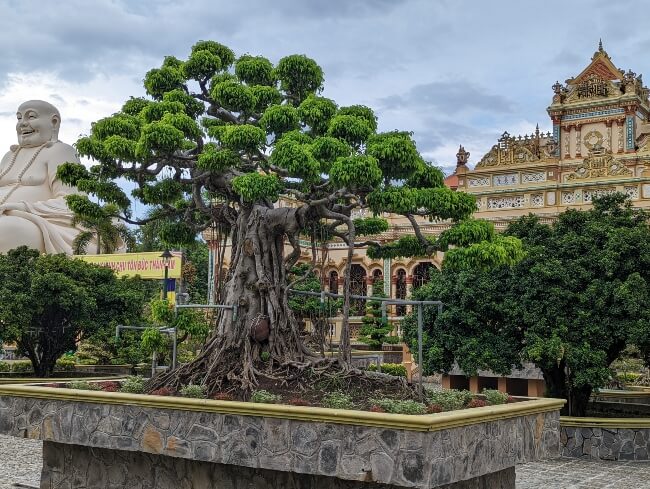
Beautiful Bonsai in Thailand.
How to Grow Bonsai Trees Indoors
All bonsai trees prefer to be outdoors, but if you do grow them indoors, you need to give them an environment that is as close as possible to their natural habitat.
All trees like light, it’s why they grow so tall in nature - it means they reach the top of the forest and get the highest possible amount of sunlight for their canopies. Fruiting bonsai especially need light as it helps their fruits to ripen.
For a guide to watering, mimicking the world outside the window is the best guide, but don’t overwater just because there’s a sudden flash flood.
Mature trees are resilient to temperature changes and flooding, but bonsai should be given careful care, especially those grown indoors that are less used to the elements.
Water when the soil has mostly dried out, and not before then and try to keep them in full view of a bright window. For indoor bonsai fruit trees, you’ll need to manually pollinate them to support fruit production.
This is really easy to do and just means tickling the insides of each flower with a small soft-bristled paintbrush. The brush picks up pollen and transfers it between male and female flowers.
For bonsai apple trees, you may need to have two trees and ensure that one is male and the other is female as some varieties of apple require another tree to pollinate them successfully, which is no different for bonsais - check the variety of any fruit tree for pollination guides.
How to Propagate Bonsai Trees
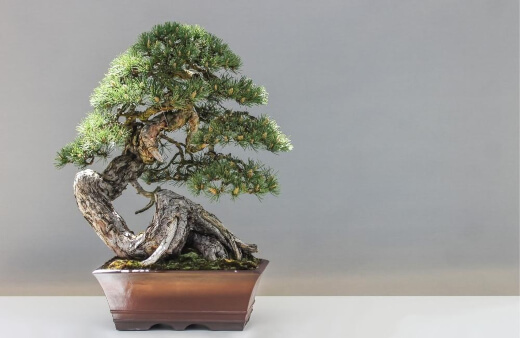
There are several ways to propagate bonsai trees and if you’re planning on growing bonsais for meditation or mindfulness, growing your own from seeds and cuttings brings you far closer to the life of the tree you are nurturing, having brought it into life from the very beginning.
Propagating Bonsai Trees from Seed
Growing bonsai from seed takes time and attention, and propagation depends entirely on what kind of tree you’re growing. Some seeds, like Ginkgo Biloba bonsai trees, need a period of vernalization in order to germinate, while others just need time and humidity.
To germinate tree seeds, follow any guidance to germinate the bonsai just as you would if you were germinating a full-sized tree. Start by placing the seed in a basic seed compost after any required vernalization, and covering the watered pot with a plastic bag or cloche to keep humidity levels high. Place the pot on a warm windowsill and wait until it’s germinated.
What is Vernalization?
Vernalization is a period of cold stratification, which is essentially just putting seeds in the fridge for 2 to 3 weeks to trick them into thinking they’ve been through a winter. It’s important for many hard-shelled seeds.
Propagating Bonsai Trees from Cuttings
By far the best way to grow new bonsai trees is from basal cuttings in the garden. Plants like holly, or Buxus, provide wonderful material for this method of bonsai propagation as they like to send up what are called ‘volunteers’.
Volunteers are new plants that grow up from the roots of the first plant. They can become as tall as the original plant and eventually provide their replacement, and they can be taken at any age to create a striking and unique bonsai.
To take a basal cutting for a new bonsai from Buxus, prepare the plant in spring by cutting it right back to 4-6” above the soil level.
The Buxus will send new shoots out from the cut trunk in summer, and at that point, you can dig the entire thing out of the ground, trim the roots carefully so they will fit in a large bonsai tray, and then cut back any growth longer than 8” that could put strain on the plant while it establishes in its new space.
The following summer, when it begins to grow more vigorously, start pruning the plant and training with strong brass, steel or copper wires (the wires add beauty by themselves so choose a wire you like as it can stay in place until the branch starts to develop mature bark).
Caring for Bonsai
Bonsai care is really simple, and we’ve covered it briefly above. There are some specific needs, like how to change a bonsai’s pot, and how to prune bonsai, but for the most part, watering, feeding and light are just a case of recreating nature.
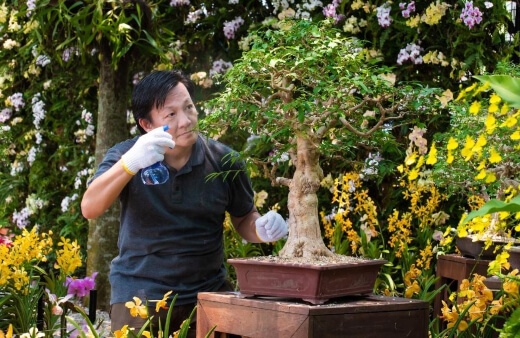
Watering Bonsai
While many house plants suggest watering when the soil completely dries out, bonsais are a little different. In nature, if the soil is completely dry it’s called a drought. Trees can withstand drought but they don’t like it.
The best time to water a bonsai is when the soil is starting to dry out, but still slightly moist just under the surface.
Make sure to completely wet the bonsai so that water runs right through the holes at the base of the pot. A healthy bonsai tree’s roots will drink as much water as you give it.
Rainwater is best for bonsai trees because it's softer, less chemically fortified and mimics their natural requirements better.
Whatever you do, make sure you don’t allow your bonsai tree to sit in water, and if you’ve recently bought a bonsai tree from a garden centre check its roots for signs of rot as general supplies of mass-produced bonsais typically water them incorrectly and leave them sitting in water, which makes them look great on the shelf but can kill them within weeks of buying them.
How to Fertilise Bonsai
Most bonsai trees don’t need specific fertilisers but there are some really excellent general-purpose bonsai fertilisers you can buy online to give your plants a boost.
For bonsai citrus fruits, a citric fertiliser or liquid seaweed heavily diluted in your normal water is a useful addition to support fruit production and flowering.
And for other fruits like bonsai apples, cherries or crabapples, repotting them into fresh bonsai soil with some sterilised compost will give them a gentle boost to help with fruiting.
Check out this guide to learn more about crabapples and its many varieties.
How to Care for Young Bonsai Trees
Once the seed has germinated, water it gently every 3 to 4 days (or whenever the bonsai soil is dry). When it has two pairs of true leaves (small replicas of the full-size tree’s leaves that will usually appear at about 2-3” tall), pinch out the top pair of leaves to encourage side shoots. These shoots will form the main shape of your young tree.
When your bonsai tree has developed two small main stems you can carefully repot the bonsai into a bonsai tray. Make sure the tray is small enough to restrict the roots, but not so small that they have nowhere to go (a bonsai tray that’s 2-3” across will be fine).
Then wait until the small branches begin to stiffen slightly and use thin copper wire to gently train them into your desired base shape.
Pruning Bonsai

There are bonsai traditionalists who will only ever stick to the traditional triangular bonsai forms that directly mirror nature, and seek to display perfectly miniaturised trees, but there are some really exciting bonsai artists making contemporary bonsai all over the world.
For the two sessions below I’ll give a summary of the style and some notes on how to achieve it.
Whatever pruning style you choose, remember it’s not about constant pruning, as the tightly contained roots will slow the growth rate down enough that you only need to prune mature bonsai twice a year.
Newcomers to bonsai often make the mistake of pruning every time they see a branch out of place, but this leads to clumping and can trigger disease while the trees fail to heal properly between cuts.
Traditional Bonsai Pruning
Bonsai takes time and effort, and there are only a handful of true bonsai masters in the world who can truly claim to have mastered the art of bonsai, but all of them follow the same basic principles of shape and health.
Traditional bonsai pruning is all about the pyramid. Bonsai should look like a triangle from all angles, with a bare trunk at the base before the branches shoot horizontally outwards, tapering up through twisting limbs to a naturally rounded tip.
This basic form gives a lot of freedom to bonsai artists to train new branches on copper or steel wire as it grows to create ever more intricate and twisted branches with clusters of leaves shooting out from carefully selected points.
For amateur growers, the skill can be simplified by just snipping out old growth in winter to promote fresh shoots from that point in spring, and trimming back any new growth in summer to maintain a shape.
For some trees like pine and conifer pinching out the leaves can give a more natural appearance as they begin to bush out during the season, but as long as you follow the basic rules of tree pruning and keep on top of summer growth spurts you’ll be able to maintain a neat bonsai tree in no time.
Contemporary Bonsai Pruning
The ever-evolving art of bonsai pruning has no right standards and is based on a system of horticulture developed in China but developed in Japan, so while traditionalists will always stick to the Japanese ideals when pruning bonsai there are more and more bonsai growers pruning more creatively, and creating magnificent bonsais that are truly breath-taking.
With some bonsai growers seeming to defy gravity with asymmetric, leaning, trees, it’s easy to get carried away as a newcomer and aim too big too soon but it’s worth keeping it simple when you start out and developing your own style as you go.
Maybe consider aiming for a simple windswept bonsai, or a pleached bonsai fruit tree to mimic traditional European kitchen gardens.
Whatever style you choose, the method is the same. Pruning bonsais means pinching out new growth as it appears knowing that most trees will send new shoots out from the nearest bud to the cut point, and cutting back new growth in summer to adjust the shape.
Best Bonsai Pruning Kits Reviews
1. Hanafubuki Wazakura Japanese Bonsai Garden Tool Starter Kit

This set of three beautifully built and traditional bonsai tools is a tool starter kit rather than a full bonsai tool kit, but it doesn’t disappoint.
If you’re going to buy a bonsai tool kit and you’re starting out then this is a great basic bonsai kit to get you started, but more importantly, it’s beautiful, with a copper bound traditional Chinese broom included in the kit.
Pros
Cons
2. BonsaiOutlet Tinyroots 5 Piece Carbon Steel Pruning Kit

While I’m a fan of more functional contemporary tool kits, I really love this more traditional bonsai kit that focuses on the beautiful forms and balance of transitional bonsai tools.
The wooden box provided with the tool kit is a lovely touch too, so you can store bonsai tools neatly and safely together.
Pros
Cons
How and When to Re-pot a Bonsai Trees

Repotting bonsai trees is a bit of a contentious issue because it’s usually only necessary if you’ve missed out on root trimming for a few years. If your bonsai needs repotting, take the opportunity to replace its soil, and only ever re-pot to a tray 1” larger than its existing tray.
If you give bonsai roots space to grow too much, they will spring into growth more and try to jump-start the top growth of the tree that can ruin its shape very quickly, so limit the tray size, and use purpose mixed bonsai compost.
Bonsai Root Pruning
If you see roots appearing from the hole at the base of a bonsai pot, it’s much better to root prune than to re-pot. Pruning roots keeps a healthy fibrous bonsai root system and means your tree can be kept in the same pot for much longer.
To prune bonsai roots, remove the tree from the pot and gently lay it on its side. For young trees or brittle trees, take care to support the main trunk and delicate branches.
Shake the soil off by gently rubbing the outside of the root ball with clean hands, and using sterilised bonsai scissors, evenly cut the outside ½ inch of exposed roots back to the root ball.
When you’ve cut the roots back, shake the soil a little further, and place your tree back in its pot with new compost around the edges.
How to Get Started with Bonsai Trees
As well as starting bonsais from seeds and cuttings there are some excellent bonsai start kits online that offer a wider range of trees than bonsai nurseries.
Established bonsai can cost thousands of dollars, and while they are carefully crafted by experts have one important thing missing - your own personal touch.
Bonsai starter kits get you started with specifically selected seeds, compost and trays that see you through the first few years of bonsai growth. We’ve selected our favourite bonsai kits to buy online in Australia.
Best Bonsai Starter Kits in 2025
1. Bonsai Grow Kit - Small Leaf Fig
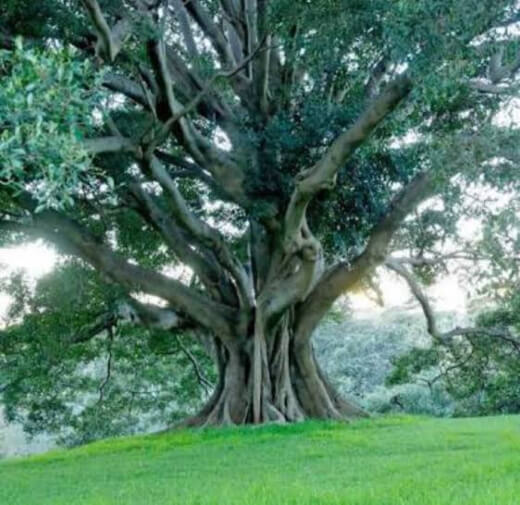
The small leaf fig bonsai grow kit from Bonsai Boy comes with loads of seeds to help give you a better chance of germination, but small leaf figs are actually pretty simple to germinate, so you might even get a few extra bonsai with this kit.
The simple blue ceramic dish is perfect for starting young plants off once they’ve germinated in the more controlled environment of the seed pot with bonsai compost.
Pros
Cons
2. Bonsai Grow Kit - Maple
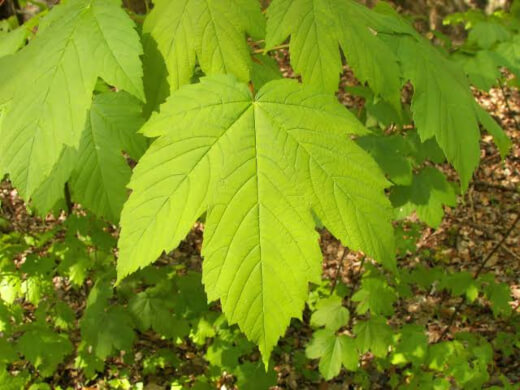
You won’t find a more Japanese tree for bonsai than a Maple. They are inescapably Japanese plants that hold cultural connotations in every leaf, and in every flake of bark.
Maples are incredibly elegant bonsai, and when you finally reach the point where you can call your bonsai a ‘mature bonsai’, you’ll be even more in love with it thanks to the smooth bark that twists and tears, unlike any other bonsai.
Maples aren’t the easiest trees to germinate, but with multiple seeds provided, you’ll have a really high chance of germinating them. Thankfully, if you don’t succeed, maple seeds are pretty cheap to buy online so you can carry on with the same kit.
Pros
Cons
Common Bonsai Tree Pests and Diseases
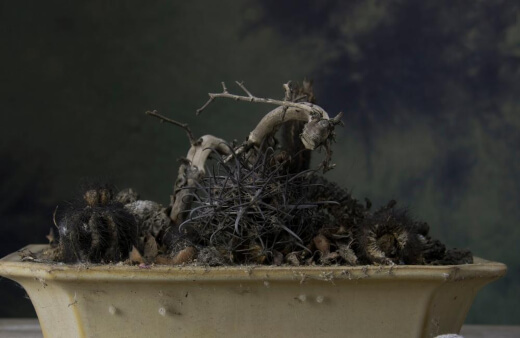
Pests
There is only really one general pest that will affect any bonsai, but it’s limited to indoor bonsai and usually attributed to infestations on other house plants.
Mealybugs will set up home on almost any plant and are an incredibly difficult pest to get rid of, but regularly cleaning leaves and manually removing them with tweezers or rubbing alcohol is effective.
Other pests relate specifically to the tree you are growing. For example, thrips are attracted to fruiting bonsai, and spider mites are attracted to any particularly fragrant bonsai trees.
Organic pesticides are useful, but generally maintaining a good structure, and keeping them properly aerated outdoors will prevent most pests from becoming a problem.
Diseases
As above, bonsai tree diseases are unique to each variety of bonsai tree, but there are one or two things you can do to improve their health. Maintaining a healthy root system not only adds vigour and verdancy to bonsai leaves, but it gives you a chance to check on the roots.
If the young fibrous roots around the outside of a bonsai tray are turning black, you need to cut back to healthy roots (these will be white, green, cream, yellow, or pale brown depending on the tree.
Shake off all soil if root rot is apparent and replace it when the affected roots have been removed.
There are many trees that suffer from leaf spots for various reasons (again, relating to individual species) but in general it’s best to keep an open shape for good airflow which prevents fungus from taking hold, and don’t over-humidify mature plants.
Think, would this work in nature? A mature full-sized tree is rarely subject to high humidity, and rain falls quickly from the leaves to the floor. Mimic this in your garden by watering at the base, not the leaves.
Bonsai Tree FAQs
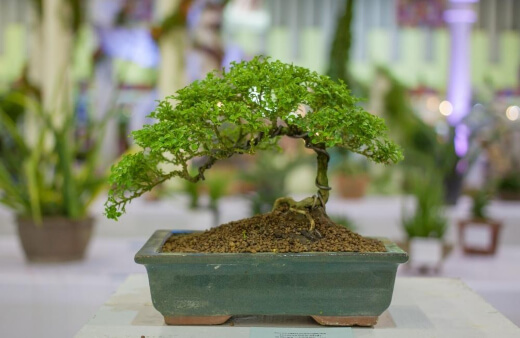
What is the easiest bonsai tree to grow?
All bonsai trees have their challenges, but most bonsai growers will tell you that juniper bonsai trees are the easiest bonsais to grow. Their bark thickens at a young age and they respond very well to wire supports and, unlike most evergreen bonsais, can be cut into old wood.
How long does a bonsai tree take to grow from seed?
Bonsai trees can take up to ten years to look like recognisably gnarled bonsai trees with all their twisting beauty but you can grow a bonsai tree from seed within a matter of weeks, and by growing bonsai from seed you connect to your plant from its inception.
Are bonsai trees good for meditation?
Bonsai trees are brilliant tools for mindfulness meditation as they connect us to nature and to the garden in a way that no other plant can. By working towards nature in miniature we can better understand its beauty and appreciate it in direct action.
Can I keep a bonsai tree outdoors?
Bonsai trees should be kept outdoors rather than indoors as it’s much easier to mimic their natural environment in these settings, remembering at all times that bonsai are trees, not houseplants, so need cold spells and, unlike most ornamental plants, they actually enjoy the erratic outdoor climate.
Start Enjoying the Benefits of Growing Bonsai Trees Today
As you might be aware by now, I’m pretty obsessed with bonsai and its history, but there are bonsai artists who will have their own take on all of this advice as the ever-evolving art of bonsai is unmistakably personal to every grower.
This ultimate guide to growing bonsai trees should, therefore, be used as a guide for you to make your own rules, and decide your own shapes and patterns once you’ve chosen a tree that will fit perfectly with your life, as it's something you’ll be tending to for the rest of your life.

Published on February 2, 2022 by Maisie Blevins
Last Updated on December 28, 2025




